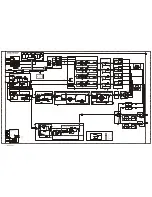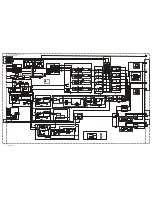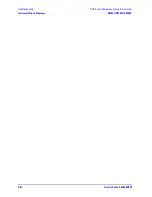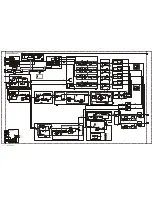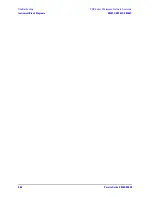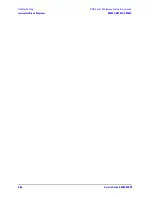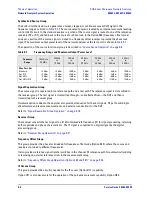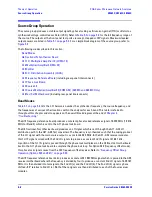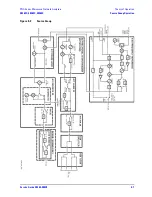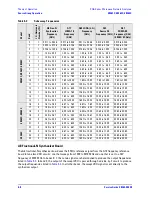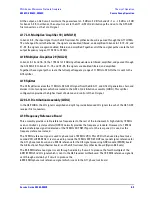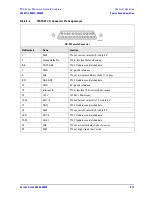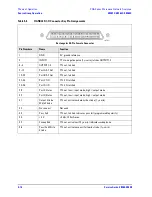
5-4
Service Guide E8364-90038
Theory of Operation
PNA Series Microwave Network Analyzers
Network Analyzer System Operation
E8362C, E8363C, E8364C
Synthesized Source Group
The built-in synthesized source generates a swept, stepped, or continuous wave (CW) signal in the
frequency ranges as listed in
Table 5-1
. The source output power is leveled by an internal automatic leveling
control (ALC) circuit. In the standard analyzer, a portion of the source signal is routed to one of the reference
receivers (R1 or R2), and fed back to the source for phase lock. In the Option 080 (frequency offset mode)
analyzer, a portion of the source signal is routed to a frequency offset receiver to provide the phase lock
signal. The maximum output power level of the network analyzer at the test ports is shown in
Table 5-1
.
The operation of the source functional group is described in
“Source Group Operation” on page 5-6
.
Signal Separation Group
The source signal is separated into a reference path and a test path. The reference signal is transmitted to
the receiver group. The test signal is transmitted through—and reflected from—the DUT and then is
transmitted to the receiver group.
Hardware options added to the analyzer also provide attenuation for the test signals, RF path switching to
allow forward and reverse measurements, and external connections for the DUT.
Refer to
“Signal Separation Group Operation” on page 5-16
.
Receiver Group
The receiver converts the test signal to a 41 kHz intermediate frequency (IF) for signal processing, retaining
both magnitude and phase characteristics. The IF signal is converted to a digital signal by the digital
processing group.
Refer to
“Receiver Group Operation” on page 5-21
.
Frequency Offset Group
This group provides the phase lock needed for frequency offset mode (Option 080), where the source and
receivers are tuned to different frequencies.
It also provides reference signal transfer switches in the channel R1 reference path for automatically adding
or removing an external reference mixer in the measurement setup.
Refer to
“Frequency Offset Group Operation (Options 080 and 081)” on page 5-24
.
IF Access Group
This group provides the circuitry needed for the IF access (Option H11) capability.
Option H11 is also necessary for the operation of the pulse measurement capability, Option H08.
Table 5-1
Frequency Range and Maximum Output Power Level
Frequency
Range
10 MHz to
45 MHz
45 MHz
to
10 GHz
10 GHz
to
20 GHz
20 GHz
to
30 GHz
30 GHz
to
40 GHz
40 GHz
to
45 GHz
45 GHz
to
50 GHz
Max. Pwr. Out
Standard
Opt. 014
Opt. UNL
Opt. UNL/014
+2 dBm
+2 dBm
0 dBm
0 dBm
+5 dBm
+5 dBm
+3 dBm
+3 dBm
+3 dBm
+2 dBm
+1 dBm
0 dBm
0 dBm
-2 dBm
-2 dBm
-4 dBm
-4 dBm
-6 dBm
-6 dBm
-8 dBm
-5 dBm
-7 dBm
-9 dBm
-11 dBm
-10 dBm
-12 dBm
-15 dBm
-17 dBm
Summary of Contents for E8362C
Page 11: ...Service Guide E8364 90038 1 1 1 Safety and Regulatory Information ...
Page 21: ...Service Guide E8364 90038 2 1 2 General Product Information ...
Page 33: ...Service Guide E8364 90038 3 1 3 Tests and Adjustments ...
Page 81: ...Service Guide E8364 90038 4 1 4 Troubleshooting ...
Page 137: ...Service Guide E8364 90038 5 1 5 Theory of Operation ...
Page 171: ...Service Guide E8364 90038 6 1 6 Replaceable Parts ...
Page 257: ...Service Guide E8364 90038 7 1 7 Repair and Replacement Procedures ...
Page 341: ...Service Guide E8364 90038 8 1 8 General Purpose Maintenance Procedures ...




